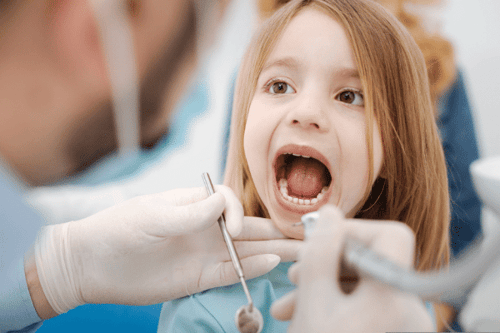
The American Dental Association (ADA) recognizes Early Childhood Caries as a significant public health problem among preschool-age children.

Cavities affect the general population, but they disproportionately affect low-income, Latino, and African American children. According to the Center for Disease Control and Prevention (CDC), in the United States, children from low-income families are twice as likely to have cavities than children from higher-income households.
Tooth decay exacerbates existing barriers to equality. Children with dental disease are more likely to get lower grades and miss more school than children with healthy teeth. Cavities can cause physical pain and emotions such as shame and embarrassment, which can impair a child’s ability to learn, play and socialize.
The World Health Organization (WHO) states that Early Childhood Caries are a prevalent oral disease on the continents of America and Asia, where processed foods and refined sugar have replaced many traditional foods. Currently, dental decay appears to be less prevalent on the continent of Africa, but this is changing as processed, sugary foods displace ancestral diets.
Cavities, caries, and tooth decay all refer to the same basic issue, and are often used interchangeably.
Cavities are small holes that form on the surface of the tooth. These pitted holes are caused by caries (tooth decay). Tooth decay is caused by a buildup of bacteria and acid on the tooth. This acid is produced as a result of excess sugars and starches left over in the mouth after you eat or drink.

In order to understand why we get cavities, we must first understand the epic battle that is waged in your mouth every single day. The battlefield is your oral cavity, which includes your gums, oral walls, teeth and tongue. On one side are harmful bacteria that eagerly consume sugars. On the other side is your tongue and your saliva, defending your teeth from acid attack. As long as your saliva has enough of the right minerals from the food you eat, it will faithfully and continuously deposit calcium, phosphate and fluoride in your mouth to remineralize your teeth.
Your mouth is home to around 600 species of bacteria — tiny microorganisms living in a community called a microbiome. Many of these bacteria are harmless or even beneficial, but some (like Streptococcus mutans) are a problem because they cause tooth decay.
A healthy mouth has a balanced microbiome, and is able to keep bacterial populations in check. When harmful bacteria grow more quickly than the body is able to neutralize them, acid and decay are sure to follow.
Saliva is a neutral alkaline fluid made up of water, protein, salts and enzymes. It is constantly flowing through our mouths, and it does more for our health than we ever give it credit for.
In addition to these important functions, saliva attempts to keep bacteria in check, neutralize acid, and remineralize the enamel of the teeth. Your saliva wages a constant battle to protect the enamel of your teeth. Each wave of healthy saliva deposits calcium, phosphate, and fluoride into the enamel to naturally heal and rebuild your teeth. This process is called remineralization.
Both types of carbohydrates, simple and complex, have the same effect in the mouth — any particles left behind will feed the bacteria and create tooth-destroying acid.
Because they are hard and inflexible, it is easy to forget that the teeth are actually living, sensory organs.
The longer acid (the byproduct produced when bacteria consumes sugar) goes unchecked, the deeper the acid holes become in the enamel. Eventually, an untreated cavity will penetrate the dentin and reach the pulp, exposing the nerves and causing excruciating pain. At this point, the entire tooth can become infected and will need to be extracted.
The good news is, there is a lot we can do to help babies and children win the battle against dental caries.

Thankfully, cavities are preventable, which means that with increased awareness, advances in pediatric dentistry and public health measures, we can vastly improve children’s dental health. With a proactive approach, we can turn the tide on tooth decay.
If you notice cavity symptoms in your child, there is no time to waste! Take solid steps to stop dental caries before they get worse, and focus on preventing them in the future.
The three most common approaches to cavity prevention are:
At health:latch, we believe that holistic solutions to the problem of tooth decay in children go well beyond this.
From a public health perspective, the disparities of ECC point to systemic issues that have yet to be resolved in America and the world. We believe that all children deserve access to quality preventative dental care and healthy tooth-building food, especially children of color from low-income families.
Every single baby should have their first dental appointment BEFORE their first birthday, including children from low-income families without insurance. Children who receive preventative dental check-ups and regular cleanings are much less likely to develop cavities. Education and support for parents (ideally starting before birth) can help them prepare for their baby’s gum and tooth care.

Babies and children should be screened for oral restrictions at birth and in early childhood. Tongue ties, lip ties and buccal ties are related to mouth breathing, enlarged tonsils, tooth crowding, jaw issues, and so much more. All of these issues contribute to tooth decay. Early Childhood Caries can be greatly reduced and prevented by addressing oral restrictions as early as possible with a proper release procedure and follow-up care with a circle of healthcare professionals.
In his book The Dental Diet, the Australian dentist Dr. Steven Lin highlights the importance of a healthy diet for healthy teeth. He advocates for a return to ancestral foods rich in minerals, fat-soluble vitamins, and healthy fats for both oral health and overall health. A healthier diet for children will not only reduce their consumption of processed simple carbohydrates and sugary foods — it will actually strengthen their teeth from within so that their enamel will be stronger and less susceptible to decay.
Nutrition education on its own is not enough. We must also support efforts to make whole, unprocessed and nutrient-rich foods accessible and affordable for low-income families in both urban and rural areas. Projects like the Edible Schoolyard put free sustainable school lunches in public schools and promote hands-on nutrition education for children.
Oral development begins in the womb. During pregnancy, women are more likely to experience cavities because the body will actually reallocate minerals from the teeth for the benefit of the growing fetus. Making sure that pregnant moms have a healthy diet complete with tooth-building minerals will protect their own dental health from cavities, as well as provide their growing fetus with the nutrients it needs for healthy oral development.
The bottom line is that it is up to us as parents and healthcare providers to come together to turn the tide on early childhood cavities.
Treating early childhood cavities (ECC) requires a multi-disciplinary approach that gets to the "root cause" of its presence. If you suspect an oral restriction could be the cause of your child’s chronic cavities, surround yourself with healthcare providers who can help.
To set yourself up for success, you want a team that communicates with each other across disciplines for a holistic health approach. A custom approach to address accompanying issues like oral restrictions, speech & language issues, and airway health & sleep will help your family have the best possible outcome.